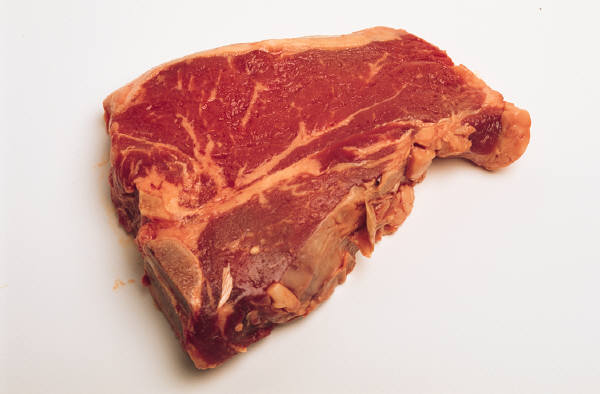Have you ever been in the grocery store and picked up a package of bright red hamburger? What do you do when the steak that you bought for dinner has an iridescent look to it?
We live in a world where we eat with our eyes as much as our mouth. The way food looks affects our perception of how it will taste. Below are a few questions and answers from the USDA Food Safety and Inspection Service (www.fsis.usda.gov) about the color of meat.
What factors affect the color of meat and poultry?
Myoglobin, a protein, is responsible for the  majority of the red color. Myoglobin doesn’t circulate in the blood but is fixed in the tissue cells and is purplish in color. When it is mixed with oxygen, it becomes oxymyoglobin and produces a bright red color. The remaining color comes from the hemoglobin which occurs mainly in the circulating blood, but a small amount can be found in the tissues after slaughter.
majority of the red color. Myoglobin doesn’t circulate in the blood but is fixed in the tissue cells and is purplish in color. When it is mixed with oxygen, it becomes oxymyoglobin and produces a bright red color. The remaining color comes from the hemoglobin which occurs mainly in the circulating blood, but a small amount can be found in the tissues after slaughter.
Color is also influenced by the age of the animal, the species, sex, diet, and even the exercise it gets. The meat from older animals will be darker in color because the myoglobin level increases with age. Exercised muscles are always darker in color, which means the same animal can have variations of color in its muscles.
Optimum surface color of fresh meat (i.e., cherry-red for beef; dark cherry-red for lamb; grayish-pink for pork; and pale pink for veal) is highly unstable and short-lived. When meat is fresh and protected from contact with air (such as in vacuum packages), it has the purple-red color that comes from myoglobin, one of the two key pigments responsible for the color of meat. When exposed to air, myoglobin forms the pigment, oxymyoglobin, which gives meat a pleasingly cherry-red color. The use of a plastic wrap that allows oxygen to pass through it helps ensure that the cut meats will retain this bright red color. However, exposure to store lighting as well as the continued contact of myoglobin and oxymyoglobin with oxygen leads to the formation of metmyoglobin, a pigment that turns meat brownish-red.
Does a change in color indicate spoilage?
Change in color alone does not mean the product is spoiled. Color changes are normal for fresh product. With spoilage there can be a change in color—often a fading or darkening. In addition to the color change, the meat or poultry will have an off odor, be sticky or tacky to the touch, or it may be slimy. If meat has developed these characteristics, it should not be used.
Can cooked ground beef still be pink inside?
Yes, ground beef can be pink inside after it is safely cooked. The pink color can be due to a reaction between the oven heat and myoglobin, which causes a red or pink color. It can also occur when vegetables containing nitrites are cooked along with the meat. Because doneness and safety cannot be judged by color, it is very important to use a food thermometer when cooking ground beef. To be sure all harmful bacteria are destroyed; cook all ground beef products to an internal temperature of 160 °F throughout.
What causes iridescent colors on meats?
Meat contains iron, fat, and other compounds. When light hits a slice of meat, it splits into colors like a rainbow. There are various pigments in meat compounds that can give it an iridescent or greenish cast when exposed to heat and processing. Wrapping the meat in airtight packages and storing it away from light will help prevent this situation. Iridescence does not represent decreased quality or safety of the meat.
Author: Kate Shumaker, Extension Educator, Family and Consumer Sciences, Ohio State University Extension.
Reviewed by: Christine Kendle, Extension Educator, Family and Consumer Sciences, Ohio State University Extension.
Source: The Color of Meat and Poultry. USDA Food Safety and Inspection Service. Retrieved from www.fsis.usda.gov on 10/24/14.
